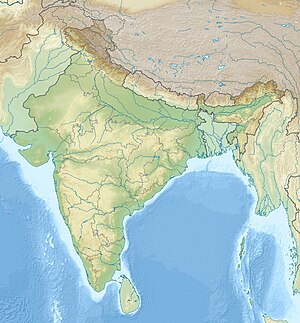Expedition to Kalinjar (1531)
| Expendition to Kalinjar | |||||||
|---|---|---|---|---|---|---|---|
| |||||||
| Belligerents | |||||||
|
| Chandelas of Kalanjara | ||||||
| Commanders and leaders | |||||||
|
|
Rudra Pratap (Prataprudra deo) | ||||||
| Strength | |||||||
| ~Unknown | ~Unknown | ||||||
| Casualties and losses | |||||||
| ~Unknown | ~Unknown | ||||||
Location of Expendition of Kalinjar (1531) | |||||||
The Expedition of Kalinjar (1531)[2][3]or Attack on Kalinjar (1531)[4] led by Mughal Emperor Humayun was a crucial military campaign aimed at besieging the Kalinjar fort. At that time, the fort was under the rule of Rudra Pratap Singh of Bundelkhand, also known as Prataprudra Deo of Kalinjar. Humayun managed to bring the raja under Mughal suzerainty, transforming the fort into an advanced Mughal military base and strategic stronghold in northern India. This conquest significantly bolstered Mughal control over the region and expanded their territorial influence.[4]
Background
[edit]Within six months of ascending to the throne, Humayun took on the formidable task of besieging the fortress of Kalinjar in Bundelkhand. The ruler of the fortress was believed to have allegiances with the Afghans, prompting Humayun's military action to secure the strategic stronghold.[5]
Raja Rudra Pratap of Kalinjar sought to expand his territory, prompting Humayun to take punitive action against him and lead an expedition. Upon reaching Kalinjar, Humayun demanded the raja's surrender, but Rudra Pratap adamantly refused to comply.[6][7]
The Siege
[edit]Humayun advanced to Kalinjar, initiating a prolonged siege that endured for several months. Amidst this campaign, news regarding the emergence of Mahmud Lodi caused confusion for Humayun. Despite the challenging circumstances, Humayun persisted with the siege. Though the Chandela ruler had a formidable reputation for bravery, he eventually surrendered Kalinjar to Humayun following a month-long siege.[8][9] In exchange for accepting Humayun's suzerainty, he was permitted to retain control of the fort.[10][11][12]
The Aftermath
[edit]In 1531, Humayun strategically sought to gain the acceptance of the fragmented nobility by making a play for Kalinjar. In negotiations with the Raja Rudra Pratap ,from the house of Chandelas of Kalanjara, an offer of 6,720 tolas of gold was presented in exchange for peace. Humayun agreed to the terms and, in doing so, assumed the title of Ghazi for his perceived act of 'subduing an infidel.'After taking the surrender of Raja,Humayun Marched out to Supress Mahmud Lodi whom he defeated and subdued.[13][14]
See also
[edit]References
[edit]- ^ Islamic Culture. 1996. pp. 70–72, 77."During he time of Humayun, Raja Pratap Rudra of Kalinjar opposed him in the beginning and refused to accept his overlordship, but later on when he submitted to Humāyün and gave himpeshkash he was allowed to"
- ^ Mahajan, Vidya Dhar (1967). India Since 1526. S. Chand. p. 20.
- ^ Mahajan, Vidya Dhar; Mahajan, Savitri (1962). The Muslim Rule in India. S. Chand. p. 19.
- ^ a b Sharma, L. P. (1989). History of Medieval India (1000-1740 A.D.). Konark Publishers. p. 289. ISBN 978-81-220-0042-9.
- ^ Avasthy, Rama Shanker (1967). The Mughal Emperor Humayun. History Department, University of Allahabad. pp. 90–91.
- ^ Sharma, L. P. (1989). History of Medieval India (1000-1740 A.D.). Konark Publishers. p. 289. ISBN 978-81-220-0042-9.
- ^ Journal of Indian History. Department of Modern Indian History. 1988. p. 35.
- ^ Chandra, Satish (2005). Medieval India: From Sultanat to the Mughals Part - II. Har-Anand Publications. p. 51. ISBN 978-81-241-1066-9.
- ^ Islamic Culture. 1996. pp. 70–72, 77.
- ^ Qanungo, Kalika Ranjan (1965). Sher Shah and His Times. Orient Longmans. pp. 123–125.
- ^ Teacher Eligibility Test Social Studies (For Classes VI-VIII). Upkar Prakashan. pp. 91T. ISBN 978-93-5013-213-5.
- ^ Rao, B. S. L. Hanumantha; Rao, K. Basaveswara (1958). Indian History and Culture. Commercial Literature Company. p. 14.
- ^ Congress, Indian History (1972). Proceedings. Indian History Congress. pp. 392–393.
- ^ Ratna, Kalpish (2023-12-12). Bahadur Shah of Gujarat: A King in Search of a Kingdom. Simon and Schuster. ISBN 978-93-92099-95-3.
This article needs additional or more specific categories. (August 2024) |

